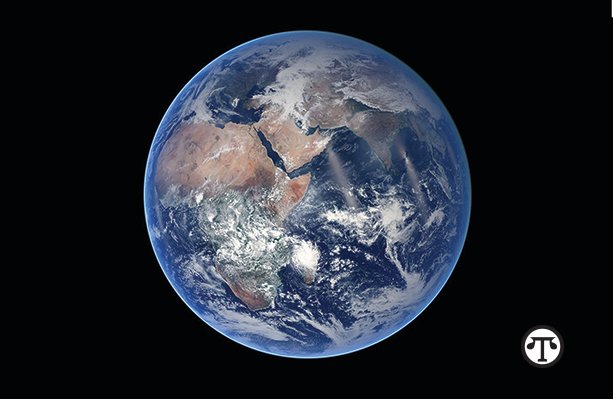 Post Classifieds
Post Classifieds
Climate Change Likely Shifted The Axis Of The Earth, According To A New Study

(NAPSI)—Global warming that caused glacial melting is likely the cause of a shift in the movement of the Earth’s poles in the 1990s, according to a new study in Geophysical Research Letters, AGU’s journal for high-impact, short-format reports with immediate implications spanning all Earth and space sciences.
Melting glaciers redistributed enough water to cause the direction of polar wander to turn, and accelerate, eastward, according to the new research.
“The faster ice melting under global warming was the most likely cause,” said Shanshan Deng, a researcher at the University of the Chinese Academy of Sciences.
Changing Poles
The North and South Poles aren’t static, unchanging spots. The axis Earth spins around keeps moving.
The Earth spins around an axis kind of like a top, explains Vincent Humphrey, a climate scientist at the University of Zurich. If the weight of the top moves, the spinning top starts to lean and wobble. The same thing happens to the Earth as weight shifts from one area to another.
Changes in polar drift can occur for a number of reasons, including changes in water on land from melting glaciers and groundwater pumping.
Changing The Length Of Your Days
The change to the Earth’s axis isn’t large enough that it would affect daily life, Humphrey added. It could change the length of day we experience, he said, but only by milliseconds.
While the melting glaciers were the main driver of polar drift in the 1990s, “the groundwater contribution is also an important one,” Humphrey said. The analysis revealed large changes in water mass in California, Texas, China and India—all areas that pump large amounts of groundwater for agricultural use.
Backward In Time
Researchers discovered a way to rewind modern pole tracking analysis to learn why the Earth’s poles shifted in the mid-1990s. The new research calculates the total land water loss in the 1990s.
“The findings offer a clue for studying past climate-driven polar motion,” explained Suxia Liu, a hydrologist at the University of the Chinese Academy of Sciences.
Water Loss And Polar Drift
Using data on glacier loss and estimations of groundwater pumping, Liu and her colleagues calculated how the water stored on land changed. They found that the contributions of water loss from the polar regions was the main driver of polar drift.
“I think it brings an interesting piece of evidence to this question,” said Humphrey. “It tells you how strong this mass change is—it’s so big that it can change the axis of the Earth.”
What It Means
Liu said the research has larger implications for understanding land water storage earlier in the 20th century. Researchers have 176 years of data on polar drift. By using some of the methods in this study, it could be possible to estimate how much land water was lost in past years.
Learn More
For more information and to read the study, visit news.agu.org.
On the Net:North American Precis Syndicate, Inc.(NAPSI)
Get Top Stories Delivered Weekly
Recent The Xavier University Newswire News Articles
Discuss This Article
GET TOP STORIES DELIVERED WEEKLY
FOLLOW OUR NEWSPAPER
LATEST THE XAVIER UNIVERSITY NEWSWIRE
- Unknown Mortal Orchestra's II
- Bullet to the Head misses its target
- Casual Vacany leaves the reader feeling unfulfilled
- Songs in the Key of... "LOVE" : Players' new show to be annual event
- Respect yourself first
- The future of Xavier
- An inside look into an English professor's academic conferences and conventions
RECENT THE XAVIER UNIVERSITY NEWSWIRE CLASSIFIEDS
OUTSIDE THE LINES
- The Gap in Gum Care: Why Caring For Your Teeth’s F...
- Top Tips for Signature Scents and Better-Smelling Laundry
- A Dog Trainer’s Top Tips to Support Pets Through Life S...
- Clear the Air of Indoor Pollutants This Spring
- Stroke & Dementia in Black Men: Tips for Staying Healthy...
- Hispanics and African Americans at Higher Risk for Eye...
- African Americans at Higher Risk for Eye Disease
- Infinity Kings: Final Book In A Favorite Fantasy Series
- What You Need To Know About Keratoconus and the iLink...
- Your Child’s Tomorrow Begins Today
FROM AROUND THE WEB
- Sweeten Your Springtime Salads With Healthy Chilean Grapes
- Young Author Translates 4,000-Year-Old Text to Reveal...
- Keeping Cool and Energy-efficient Amid America’s “...
- Addressing Sarcopenia with a Healthy Diet
- Subway’s New Wraps Elevate Eating on the Go
- Family Teacher Conference Topics Beyond Academics
- Youth Take Down Tobacco
- BookTrib’s Bites: Four Reads to Kickoff Spring
- Curbing Colorectal Cancer in Minority Populations
- Taking Action to Take Down Tobacco








